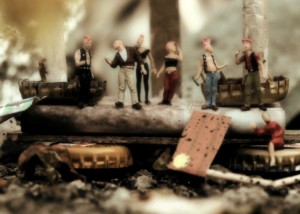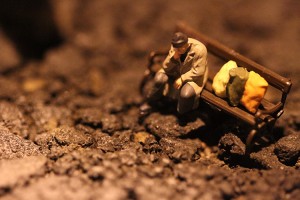Monty Python Reunite
With a constant deluge of bad news stories, one area that brings more than its share of good news stories is the arts and this week brought the particularly good piece of news that the British surrealist comedy group, Monty Python are reuniting to perform, after a 30 year break. At the news conference today they say the fact that the original humour still goes down so well after 40 years is “astounding and genuinely surprising”
The sixth member of the group, Graham Chapman died in 1989. “We’ll miss Graham quite a lot” says Idle, “but he will be there. We have told him we’re going to be on, and if there is a God then he’ll show up”. In typical Pythonesque style, the backdrop at today’s press conference reads: “One down, five to go”.
They joke that they will advertise tickets to their show as “£300 cheaper than the Rolling Stones” with tickets starting at £27.50 and go up to £95. Cleese said they would almost certainly include popular sketches such as the Crunch Frog and the Dead Parrot, but there will also be new material that has never been performed live.
The show will take place at London’s 02 Arena on 1st July 2014. Tickets go on sale on 25 November.
The comedy sketch show Monty Python’s Flying Circus started in 1969 and 45 episodes were aired over four series. Their humour expanded into radio, books , music and films and their influence on comedy has been compared to the influence of The Beatles on music. Monty Python’s Flying Circus was made all the more memorable by Terry Gilliam’s quirky artwork. Gilliam started his career as an animator and strip cartoonist.
Because Monty Python were completely self-contained with the members Graham Chapman, John Cleese, Terry Gilliam, Eric Idle, Terry Jones, and Michael Palin both writing and performing their own work, they were able to experiment beyond the rules of television comedy.
The well known song from “The Life of Brian” “Always Look on the Bright Side of Life” was performed by Eric Idle at the 2012 Olympics closing ceremony.
http://www.montypythonlive.com/
All six Python members appeared in and/or wrote the following shows before Flying Circus. The Frost Report is credited as first uniting the British Pythons and providing an environment in which they could develop their particular styles:
• I’m Sorry, I’ll Read That Again (radio) (1964–1973) [Cleese: cast member & writer] – [Idle and Chapman: writers]
• The Frost Report (1966–1967) [Cleese: cast member and writer] – [Idle: writer of Frost’s monologues] – [Chapman, Palin and Jones: writers] • At Last the 1948 Show (1967) [Chapman and Cleese: writers and cast members] – [Idle: writer]
• Twice a Fortnight (1967) [Palin and Jones: cast members and writers] • Do Not Adjust Your Set (1967–1969) [Idle, Jones, and Palin: cast members & writers] – [Gilliam: animation] — Bonzo Dog Band: musical interludes]
• We Have Ways of Making You Laugh (1968) [Idle: cast member & writer] – [Gilliam: animation]
• How to Irritate People (1968) [Cleese and Chapman: cast members & writers] – [Palin: cast member]
• The Complete and Utter History of Britain (1969) [Palin and Jones: cast members & writers]
• Doctor in the House (1969) [Cleese & Chapman: writers]
Read MoreSculptor Anthony Caro
Sir Anthony Caro, one of Britain’s top sculptors and a pioneer of modernist art died of a heart attack on Thursday (October 24th 2013).
Caro is widely regarded as the greatest British sculptor of his generation and played a major role in the development of 20th Century sculpture.
He worked as an assistant to Henry Moore in the 1950s and first came to public attention with a show at the Whitechapel Gallery in 1963 in which he exhibited large abstract sculptures which stood directly on the ground (rather than on the tradition sculptural plinths) and were brightly painted, encouraging direct interaction with the viewer.
Above: Artist Sir Anthony Caro in conversation with Julius Bryant,
Keeper of Word & Image, Victoria and Albert Museum, London.
From the BBC in Pictures: Anthony Caro
more information on their website
Picture 1 : Sculptor Sir Antony Caro, who has died at the age of 89, first came to public attention with his large abstract sculptures in the 1960s. Widely regarded as one of Britain’s greatest sculptors, his work has continued to be displayed and enjoyed around the world.
Picture 2 : The sculptor’s Month Of May (1963) – made from steel and aluminium – was on display as part of The New Situation: Art in London in the Sixties exhibition at Sotheby’s auction rooms in September.
Picture 3 : An exhibition of monumental sculptures by Sir Anthony opened at Chatsworth House in Derbyshire in 2012. The show featured steel works arranged around the Canal Pond, facing the Duke of Devonshire’s historic home.
Picture 4 : A room was given over to Sir Anthony’s steel structure Shadows when it featured in the Royal Academy’s Summer Exhibition in June.
Picture 5 : His sculpture Millbank Steps 2004 has been displayed at Tate Britain. Made from 100 tonnes of steel, it is 5 metres tall and 25 metres across.
Picture 6 : The design team behind London’s Millennium Bridge comprised of Tony Fitzpatrick, Lord Foster and sculptor Sir Anthony. The bridge wobbled when it opened in June 2000 because of what engineers called “synchronised footfall” and had to be shut down to be fixed and reopened in February 2002.
Picture 7 : A sculpture titled Blazon by Sir Anthony was one of of five of his large-scale sculptures installed on the Metropolitan Museum of Art’s Roof Garden in 2011.
Picture 8 : The sculptor designed the gold Olympic UK Kilo coin for the Royal Mint, which was unveiled at the Royal Academy in 2011.
Read MoreSeed Story
 As a lone dandelion blossoms in an abandoned parking lot, it divides the lives of several miniature people in this experimental narrative short film by award winning film maker William D. Caballero.
As a lone dandelion blossoms in an abandoned parking lot, it divides the lives of several miniature people in this experimental narrative short film by award winning film maker William D. Caballero.
Filmed in an abandoned parking lot, using a cast of carefully painted tiny model figures this experimental film focuses on the destructive addictions humanity has suffered through the ages.
The film looks at the role of religion, capitalism, environmentalism and fascism through the perspective of macro photography.
Shooting took place over two months in the Summer of 2012, on a budget of less than$3,000. Torches, sparklers and smoke guns were used to create special effects.
Shooting was done close to the ground, during both days of 90 degree heat and heavy rainstorms. The biggest disruption proved to be breezes that at times blew entire sets away.
 Directed and conceived by William D. Caballero, it premiered at the 2013 Slamdance Film Festival and at numerous festivals across the world.
Directed and conceived by William D. Caballero, it premiered at the 2013 Slamdance Film Festival and at numerous festivals across the world.
As of April, 2013, SEED STORY has screened or will screen at numerous film festivals, including a world premiere at the SLAMDANCE FILM FESTIVAL in January, 2013. The festival had a less than 2% acceptance rate making entry into it more competitive than entry into Harvard!
AWARDS:
VANGUARD AWARD (for directors who are pushing the boundaries of experimental/non-linear film) at the 2013 ART OF BROOKLYN FILM FESTIVAL!
BEST SOUND DESIGN at the 2013 VISIONFEST
BEST SHORT FILM (Honorable Mention) at the 2013 PHILADELPHIA INDEPENDENT FILM FESTIVAL
OFFICIAL SELECTIONS
- VIMEO STAFF PICK
- SLAMDANCE FILM FESTIVAL
- ATLANTA FILM FESTIVAL
- RxSM FILM EXPO
- PHILADELPHIA INDEPENDENT FILM FESTIVAL
- VISIONFEST
- KAHBANG FILM FESTIVAL
- ART OF BROOKLYN FILM FESTIVAL
- VICTORIA TEXAS INDEPENDENT FILM FESTIVAL
- XICAN INDIE FILM FESTIVAL
- INDIANAPOLIS INTERNATIONAL FILM FESTIVAL
- GUANAJUATO INTERNATIONAL FILM FESTIVAL
- PORTLAND UNDERGROUND FILM FESTIVAL
- HARLEM INTERNATIONAL FILM FESTIVAL
More to come!
To see a new short film consisting of deleted scenes from Seed Story, click here: vimeo.com/74943004
The film below was created using deleted scenes from the Seed Story film.
For more information on the project, visit wilcab.com/seedstory/
Directed, produced, shot, edited, animated, and scored by William D. Caballero
“Special thanks to the art crew and production team. I couldn’t have done it without you.”
Shigeru Ban: Revolutionary Humanitarian Environmentally Friendly Architecture
 Shigeru Ban is an accomplished international architect with an interest in humanitarianism and sustainability. He is best known for his innovative work with paper, particularly recycled cardboard tubes which have been used in many countries to house disaster victims quickly and efficiently.
Shigeru Ban is an accomplished international architect with an interest in humanitarianism and sustainability. He is best known for his innovative work with paper, particularly recycled cardboard tubes which have been used in many countries to house disaster victims quickly and efficiently.
Born in Tokyo, Japan in 1957 he studied architecture in the USA and was particularly inspired by time spent studying under John Hejeduk, the most experimentally minded of the New York Five from whom he developed an interest in ‘architectonic poetics’ or the creation of three-dimensional poetry.
An important theme in his work is “invisible structure” which incorporates the structural elements as integral parts of the design.
As a Japanese architect he uses many traditional themes and methods such as shōji and the idea of a ‘universal floor’ to allow continuity between all rooms in a house. He was also one of the first Japanese architects to embrace a combination of Japanese and Western styles.
Architects, as he says in this video, traditionally work for people with money and power but he wanted to build useful structures for everyday people.
Shigeru was working on ecological and environmentally friendly ways of building long before environmental awareness became mainstream. His explorations in the use of different building materials led to much work with paper and cardboard as the basic building material. His interest in paper stems from its sustainability as a low cost, low tech, recyclable and replaceable material.
He was surprised to discover that paper was in fact far stronger than he had expected, as well as being easy to use and easy to fireproof. With these qualities in mind he developed ways to use it as a medium for creating buildings for people in disaster areas and has used it successfully in many countries and continents.
In times of disaster, building materials are limited and prices for obtaining them rise. Developing a method for building with cardboard tubing has made it far easier to source materials.
During the Rwanda crisis, the UN provided the refugees with aluminium tubing as frames for building shelters, to try and stop the deforestation that was occurring with people cutting down trees to build with.
The refugees ended up selling the aluminium for money and then reverted to cutting down trees.
Paper tubing is cheap and more versatile than tents and the community can participate in constructing their own shelters.
Shigeru often gets local students to participate in projects and help with the construction of buildings in disaster areas. For one of their buildings he chose to use beer crates as the foundation layer. The crates were donated by a Japanese beer company and Shigeru and the students thought of sending a complaint to the donor company, he says with a twinkle in his eye, when they discovered to their disappointment that the beer crates arrived empty, rather than with itinerant containers of beer intact.
In the video he talks of the various types of buildings he has designed including many refugee shelters as well as some of the churches he has built to replace those destroyed in natural disasters.
Read MoreMandela Day: You are The Power of Change
Mandela Day is an international day in honour of Nelson Mandela,
celebrated annually on the 18th of July – Mandela’s Birthday.
It is a call to action for individuals – for people everywhere –
to take responsibility for changing the world into a better place,
one small step at a time, just as Mr Mandela did.
Following the success of Nelson Mandela’s 90th birthday celebrations in London’s Hyde Park in June 2008 and the 4664 concerts, it was decided that there could be nothing more fitting than to celebrate Mr Mandela’s birthday each year with a day dedicated to his life’s work and that of his charitable organisations, and to ensure his legacy continues forever.
The day was officially declared by the United Nations in November 2009. Mandela Day is not meant as a public holiday but is a global call to action that celebrates the idea that each individual has the ability to make an impact and the power to transform the world.
The Mandela Day campaign message is simple: Mr Mandela gave 67 years of his life fighting for the rights of humanity. All we are asking is that everyone gives 67 minutes of their time, whether it’s supporting your chosen charity or serving your local community.
Long Road to Freedom
On August 5th, 1962, an ordinary piece of road along the R103 about 3 kilometres outside Howick in KwaZulu-Natal took on extraordinary significance when armed apartheid police flagged down a car.
The man pretending to be the chauffeur had earned the nickname of the “Black Pimpernel” having evaded capture by the apartheid regime for 17 months. It was in this dramatic manner at this unassuming place that Nelson Mandela was finally captured and was to disappear from public view for the next 27 years.
Mandela had just paid a clandestine visit to ANC President Chief Albert Luthuli to report on his African Odyssey. His meeting was also to request support for an armed struggle, after having spent most of his adult life trying to find peaceful ways in which to end the injustice and suffering caused by the system of Apartheid in South Africa, without success.
50 years later on August 4th 2012, to mark the anniversary of the start of Nelson Mandela’s “long walk to freedom” a quietly powerful new sculpture was inaugurated and unveiled at this spot.
The sculpture is comprised of 50 steel column constructions, each between 6.5 and 9.5 meters tall, set into the landscape of the Natal Midlands. The posts are staggered and the portrait of Nelson Mandela only comes into correct focus when the posts line up at a position 35 meters from the sculpture (a reference to the fact that Mandela proved notoriously difficult for the authorities to find).
From this perspective the sculpture reads as a familiar photograph of Mandela, suggestive of his incarceration as one is aware it is comprised essentially of a series of steel bars, but seen from other angles the design splinters into a dynamic moment of fracture and release.
The artist Marco Cianfanelli comments on the deliberate structural paradox, that, “this represents the momentum gained in the struggle through the symbolic of Mandela’s capture. The 50 columns represent the 50 years since his capture, but they also suggest the idea of many making the whole; of solidarity. It points to an irony as the political act of Mandela’s incarceration cemented his status as an icon of struggle, which helped ferment the groundswell of resistance, solidarity and uprising, bringing about political change and democracy”.
http://www.mandela-children.org.uk/
Read More

